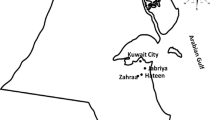Abstract
Escherichia coli strains isolated 1985–1988 in Spain from patients with diarrhoea were examined; 1170 strains were isolated from 582 sporadic cases of diarrhoea in children, and seven strains were associated with seven outbreaks of diarrhoea. Strains positive for STa enterotoxin production in the infant mouse test were also assayed for production of LT enterotoxin on Vero cells and by a coagglutination test. Thirty-one strains were STa positive: 28 were isolated from 16 (2.7 %) sporadic cases of diarrhoea and three were responsible for outbreaks. The majority of STa+LT− strains from both outbreaks and sporadic cases were serotype O153.H45 and expressed the CFA/I colonization factor antigen. Enterotoxigenic STa+LT− strains of serotype O27:H7 and STa+LT+ CFA/II+ strains of serotype O6:H15: H16 were also isolated frequently from sporadic cases.
Similar content being viewed by others
References
Levine, M. M. Escherichia coli that cause diarrhoea: enterotoxigenic, enteropathogenic, enteroinvasive, enterohemorrphagic, and enteroadherent. Journal of Infectious Diseases 1987, 155: 377–389.
Evans, D. G., Evans, D. J. New surface-associated heat-labile colonization factor antigen (CFA/II) produced by enterotoxigenicEscherichia coli of serogroups O6 and O8. Infection and Immunity 1978, 21: 638–647.
Sack, R. B. The epidemiology of diarrhea due to enterotoxigenicEscherichia coli. Journal of Infectious Diseases 1978, 137: 639–640.
Brunton, J., Hinde, D., Langston, C., Gross, R., Rowe, B., Gurwith, M. EnterotoxigenicEscherichia coli in Central Canada. Journal of Clinical Microbiology 1980, 11: 343–348.
Blanco, J., González, E. A., Bernárdez, I., Varela, B. R. Enterotoxigenic and enteropathogenicEscherichia coli in Galicia (North-West Spain). Medical Microbiology and Immunology 1983, 172: 165–169.
Danielsson, M. L., Möllby, R., Brag, H., Hansson, N., Jonsson, P., Olsson, E., Wadström, T. Enterotoxigenic enteric bacteria in foods and outbreaks of food-borne diseases in Sweden. Journal of Hygiene 1979, 83: 33–39.
Riordan, T., Gross, R. J., Rowe, B., Scotland, S. M., Johnston, S. M. An outbreak of food-borne enterotoxigenicEscherichia coli diarrhoea in England. Journal of Infection 1985, 11: 167–171.
Escribano, A., Ørskov, I., Ørskov, F., Borras, R. EnterotoxigenicEscherichia coli O153:H45 from an outbreak of diarrhoea in Spain. Medical Microbiology and Immunology 1987, 176: 241–244.
Dean, A. G., Ching, Y. C., Williams, R. G., Harden, L. B. Test forEscherichia coli enterotoxin using infant mice: applications in a study of diarrhoea in children in Honolulu. Journal of Infectious Diseases 1972, 125: 407–411.
Gonzalez, E. A., Blanco, J. Comparison between enterotoxigenic activity and methanol solubility in heat-stable enterotoxins (STa and STb) fromEscherichia coli of human, porcine and bovine orgins. Zentralblatt für Bakteriologie Mikrobiologie und Hygiene (A) 1985, 260: 1–7.
Konowalchuk, J., Speirs, J. I., Stavric, S. Vero response to a cytotoxin ofEscherichia coli. Infection and Immunity 1977, 18: 775–779.
Alonso, P., Blanco, J., Blanco, M., González, E. A. Frequent production of toxins byEscherichia coli strains isolated from human urinary tract infections: relation with haemagglutination. FEMS Microbiology Letters 1987, 48: 391–396.
Rönnberg, B., Wadström, T. Rapid detection by a coagglutination test of heat-labile enterotoxin in cell lysates from blood agar-grownEscherichia coli. Journal of Clinical Microbiology 1983, 17: 1021–1025.
Kronvall, G. A rapid slide-agglutination method for typing pneumococci by means of specific antibody adsorbed to protein A-containing staphylococci. Journal of Medical Microbiology 1973, 6: 187–190.
Blanco, J., González, E. A., Andón, R. Colonization antigens and haemagglutination patterns of humanEscherichia coli. European Journal of Clinical Microbiology 1985, 4: 316–326.
Rozgonyi, F., Szitha, K. R., Ljungh, A., Baloda, S. B., Hjertén, S., Wadström, T. Improvement of the salt aggregation test to study bacterial cell-surface hydrophobicity. FEMS Microbiology Letters 1985, 30: 131–138.
Guinée, P. A. M., Jansen, W. H., Wadström, T., Sellwood, R. Escherichia coli associated with neonatal diarrhoea in piglets and calves. In: de Leeuw, P. W., Guinée, P. A. M. (ed.): Current topics in veterinary medicine and animal science. Volume 13. Martinus Nijhoff, The Hague, 1981, p. 126–162.
Agüero, M. E., Reyes, L., Prado, V., Ørskov, I., Ørskov, F., Cabello, F. C. EnterotoxigenicEscherichia coli in a population of infants with diarrhea in Chile. Journal of Clinical Microbiology 1985, 22: 576–581.
Georges, M. C., Wachsmuth, I. K., Birkness, K. A., Moseley, S. L., Georges, A. J. Genetic probes for enterotoxigenicEscherichia coli isolated from childhood diarrhea in Central Africa Republic. Journal of Clinical Microbiology 1983, 18: 199–202.
Caprioli, A., Falbo, V., Ruggeri, F. M., Bisicchia, R., Casalino, M., Donelli, G. Comparison among enterotoxigenic strains ofEscherichia coli isolated in Italy and Somalia. European Journal of Epidemiology 1988, 4: 251–255.
Echeverria, P., Seriwatana, J., Taylor, D. N., Changchawalit, S., Smyth, C. J., Twohig, J., Rowe, B. Plasmids coding for colonization factor antigens I and II, heat-labile enterotoxin, and heat-stable enterotoxin A2 inEscherichia coli. Infection and Immunity 1986, 51: 626–630.
Levine, M. M., Ristaino, P., Sack, R. B., Kaper, J. B., Ørskov, F., Ørskov, I. Colonization factor antigens I and II and type 1 somatic pili in enterotoxigenicEscherichia coli: relation to enterotoxin type. Infection and Immunity 1983, 39: 889–897.
Echeverria, P., Ørskov, F., Ørskov, I., Plianbangchang, D. Serotypes of enterotoxigenicEscherichia coli in Thailand and the Philippines. Infection and Immunity 1982, 36: 851–856.
Rowe, B., Gross, R., Takeda, Y. Serotyping of enterotoxigenicEscherichia coli isolated from diarrhoeal travellers from various Asian countries. FEMS Microbiology Letters 1983, 20: 187–189.
Merson, M. H., Ørskov, F., Ørskov, I., Sack, R. B., Huq, I., Koster, F. T. Relationship between enterotoxin production and serotype in enterotoxigenicEscherichia coli. Infection and Immunity 1979, 23: 325–329.
Ørskov, I., Ørskov, F. Special O:K:H serotypes among enterotoxigenicEscherichia coli strains from diarrhoea in adults and children. Medical Microbiology and Immunology 1977, 163: 99–110.
Author information
Authors and Affiliations
Rights and permissions
About this article
Cite this article
Blanco, J., González, E.A., Blanco, M. et al. Prevalence of enterotoxigenicEscherichia coli strains in outbreaks and sporadic cases of diarrhoea in Spain. Eur. J. Clin. Microbiol. Infect. Dis. 8, 396–400 (1989). https://doi.org/10.1007/BF01964054
Issue Date:
DOI: https://doi.org/10.1007/BF01964054




